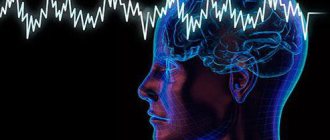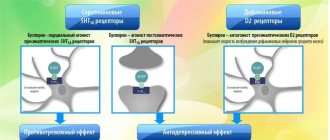Analogues of the drug according to ATC codes:
ADEPRESS ACTAPAROXETINE PAXIL PLYZIL REXETINE SIRESTILL
Before using PAROXETINE you should consult your doctor. These instructions for use are for informational purposes only. For more complete information, please refer to the manufacturer's instructions.
Mechanism of action
It is the most potent serotonin reuptake inhibitor of all SSRIs. It has weak, although much greater than other SSRI antidepressants, agonism to norepinephrine receptors; also has low affinity for dopaminergic and histamine (H1) receptors and some similarities with tricyclic antidepressants with a significantly lower ability to cause their characteristic side effects on the central nervous system and the autonomic nervous system. Shows affinity for muscarinic acetylcholine receptors, although to a significantly lesser extent than tricyclic antidepressants, as well as low affinity for α1-, α2- and β-adrenergic receptors.
Binding constants:
- SERT (Ki = 0.08 nM)
- NET (Ki = 56.7 nM)
- DAT (Ki = 573.7 nM)
The presence of a cholinolytic effect in paroxetine leads to the fact that when taken, a rapid reduction of anxiety and insomnia occurs, while the initial activating effect characteristic of the SSRI group is less pronounced, and side effects such as vomiting or diarrhea are less pronounced. Accordingly, this antidepressant may be preferable in the treatment of anxiety-phobic disorders and anxious depression, but it will be less tolerated if the structure of the depressive disorder includes pronounced mental and motor inhibition.
The ability of paroxetine in high doses to inhibit dopamine reuptake makes it similar to sertraline. However, while the beneficial effect of sertraline on cognitive function is associated with the effect on dopamine reuptake, paroxetine, on the contrary, can cause cognitive impairment. Apparently, this is due to its rather pronounced anticholinergic properties and weaker effect on dopamine receptors compared to sertraline.
Release form, composition and packaging
White film-coated tablets, round, biconvex, film-coated, scored, with a rough surface.
| 1 tab. | |
| paroxetine hydrochloride hemihydrate | 22.76 mg, |
| which corresponds to the content of paroxetine | 20 mg |
Excipients: calcium hydrogen phosphate, microcrystalline cellulose, crospovidone, copovidone, colloidal silicon dioxide, magnesium stearate, talc.
Shell composition: hypromellose, macrogol 6000, talc, titanium dioxide.
10 pieces. - blisters (3) - cardboard packs.
White film-coated tablets, round, biconvex, scored, with a rough surface.
| 1 tab. | |
| paroxetine hydrochloride hemihydrate | 34.14 mg, |
| which corresponds to the content of paroxetine | 30 mg |
Excipients: calcium hydrogen phosphate, microcrystalline cellulose, crospovidone, copovidone, colloidal silicon dioxide, magnesium stearate, talc.
Shell composition: hypromellose, macrogol 6000, talc, titanium dioxide.
10 pieces. - blisters (3) - cardboard packs.
Paroxetine instructions for use - analogues - side effects - reviews
Paroxetine is a drug from the group of antidepressants.
It is an atypical representative of selective serotonin reuptake inhibitors, since it has limited selectivity and a pronounced anti-anxiety effect.
Paroxetine is prescribed in cases where depression is accompanied by anxiety or, conversely, anxiety disorder with depression. In the fight against the combination of these two conditions, paroxetine really has no equal.
Release form
Paroxetine is available in tablet form. Each tablet contains 20 mg of active ingredient. The packaging of the drug may contain a different number of tablets, but there are 30 of them in a standard box. The original drug is produced by different companies, therefore it can be sold in different packages.
Compound
The drug contains the main active ingredient and a number of excipients. The first has the main therapeutic effect. The active ingredient of the drug is paroxetine . In this case, the drug is named after the active substance, like most original medicines.
Excipients do not have an effect on the body, but facilitate the entry of paroxetine into the body. Auxiliary ingredients include the following: cellulose, calcium, magnesium, sodium compounds and silicon dioxide. All of them are contained in negligible concentrations.
Pharmacological group
Paroxetine is a psychotropic substance. More precisely, to the group of antidepressants. In this group, drugs are divided into subgroups depending on their mechanism of action. Paroxetine is a member of the selective serotonin reuptake inhibitors.
Paroxetine is somewhat different from other representatives of its group. Its main difference is its pronounced anti-anxiety effect. According to the mechanism of influence on the body, this drug is something between an antidepressant and a tranquilizer. It is often used instead of a combination of these drugs.
Pharmacological properties
Paroxetine is a selective serotonin reuptake inhibitor. Simply put, it increases the concentration of serotonin in all parts of the brain.
Serotonin is one of the monoamine mediators that is responsible for the transmission of nerve impulses in the brain structures responsible for the emotional-volitional sphere of human activity. During depression, serotonin, like other monoamines, becomes less.
Scientists attribute decreased mood specifically to serotonin deficiency and, to a lesser extent, to dopamine and norepinephrine deficiency.
Paroxetine prevents the entry of serotonin back into the cell when it is released into the intercellular space. This increases serotonin transmission between neurons. At the same time, the synthesis of serotonin by cells increases, since it no longer comes from the outside. Thus, the concentration of this mediator in parts of the central nervous system is normalized.
Paroxetine has no pronounced selectivity. In addition to serotonin transmission, it also affects dopamine and norepinephrine transmission. This makes it somewhat similar to tricyclic antidepressants, which explains the high number of side effects.
In addition, this drug has an anticholinergic effect. It is with the latter that scientists associate the pronounced anti-anxiety effect of paroxetine. According to the anticholinergic mechanism of action, the drug is similar to tranquilizers. This allows it to be used instead of combinations of antidepressants and anti-anxiety drugs.
Indications
Paroxetine is used for mental disorders, the main manifestations of which are decreased mood or anxiety. Indications for the use of paroxetine include:
- Depressive episode of any severity;
- Recurrent depressive disorder;
- Bipolar affective disorder, current episode of depression;
- Generalized anxiety disorder;
- Panic attacks;
- Phobic anxiety disorders, regardless of the type of phobia;
- Obsessive thoughts and obsessive actions;
- Various combinations of combinations of the above disorders.
Paroxetine is prescribed by a psychiatrist or psychotherapist only if there are strict indications for the use of this drug.
When treating isolated depression, it is preferable to use newer generations of antidepressants. They have fewer side effects than paroxetine.
However, this drug is an indispensable tool for combating depression combined with an anxious component or anxiety combined with low mood.
Before the discovery of paroxetine, such conditions were treated with a combination of antidepressants and tranquilizers, which increased the risk of side effects. Paroxetine is preferable to this combination and is therefore often used in psychiatric practice.
Contraindications
Paroxetine, like any drug, has a number of strict contraindications. If the patient has at least one of them, the drug cannot be prescribed, regardless of the reason for the prescription. These absolute contraindications include:
- Individual intolerance to paroxetine;
- Taking monoamine oxidase inhibitors less than two weeks ago;
- Pregnancy and breastfeeding period;
- Childhood;
- Chronic liver failure;
- Chronic renal failure;
- Glaucoma;
- Bipolar affective disorder in the manic stage.
In addition to the listed contraindications, there are conditions in which paroxetine can be prescribed, but only with caution and under the supervision of medical personnel. These conditions include:
- History of epilepsy or seizure disorder;
- Chronic diseases of the cardiovascular system;
- Recent use of electroconvulsive therapy.
In addition, there are some features of using paroxetine simultaneously with alcohol consumption. You should learn more about them.
Side effects
Paroxetine, like most psychotropic drugs, affects many human organs and systems. First of all, changes can be observed in the central nervous system.
There are two possible diametrically opposed effects on the brain: sedative and stimulating. Most often, sedation is observed, which manifests itself as drowsiness, impaired concentration, and slow reactions.
With excitement, which is much less common, insomnia, agitation, delusions and hallucinations, aggressiveness, irritability, and panic attacks are possible.
Many patients experience tremors, headache, nausea, and sleep changes. The listed side effects disappear with systematic use of the drug. Less commonly observed is a change in taste, a transient decrease in visual acuity, and convulsions.
Paroxetine often causes a decrease in blood pressure, and collapsing states are sometimes possible. In extremely rare cases, blood pressure, on the contrary, increases. At the beginning of treatment, some patients complain of pain in the joints and muscles, which disappears with the systematic use of paroxetine.
Many patients experience sexual dysfunction. They often manifest themselves as decreased libido, impaired ejaculation, or anorgasmia. Some patients experience increased urination. Some patients may experience dry mouth, increased sweating, and impaired secretion of certain hormones. Many patients complain of weight loss or gain while taking the drug.
Particular care must be taken when treating patients with a severe depressive episode. There are known cases of suicide attempts while taking paroxetine. Such patients should begin treatment in a closed hospital under the supervision of medical personnel.
Overdose
The maximum dosage of paroxetine is 60 mg per day, which is equivalent to three tablets of the drug. If this dose is exceeded, an overdose may develop.
The latter is accompanied by a decrease in blood pressure, dry mouth, nausea, palpitations, tachycardia, and aggressiveness. The patient's pupils dilate and an irresistible desire to sleep arises.
Impaired consciousness may develop, leading to coma*.
There is no specific treatment for paroxetine overdose. To relieve an acute condition, general methods of treatment are used: gastric lavage, enema, ingestion of sorbents, detoxification infusion therapy. If symptoms of overdose are detected, you must call an ambulance.
Instructions for use
Paroxetine is taken orally once a day, regardless of the prescribed dosage.
The starting dose for any of the listed indications is 20 mg. The first week the patient takes one tablet once a day. For the treatment of some diseases, this dosage may be sufficient. For example, with mild depression, anxiety or phobic disorder.
If no response to treatment is observed after a week, the dose is increased by 10 mg. For another week the patient takes 1.5 tablets once a day. Then the dose is increased by another 10 mg to two tablets per day in the morning with meals.
A dosage of 40 mg is average therapeutic for conditions such as panic attacks and obsessions. If two tablets a day do not give any effect, the dosage is increased by 10 mg per week to 60 mg. The patient takes 3 tablets once a day in the morning.
This is the maximum dosage used in severe cases. If no positive effect is observed within a month, another drug is selected.
You cannot stop taking the drug at once. You should learn more about paroxetine withdrawal.
Analogs
There are drugs whose main active ingredient is paroxetine. Their mechanism of action is absolutely identical to the original drug. Paroxetine analogues include:
- Rexetine;
- Paxil;
- Paroxin;
- Adepress;
- Sirestill;
- Plizil;
- Seroxat.
The active ingredient of all of these drugs is paroxetine. The listed drugs are classified as generics because they are newer generations of the original substance.
These drugs differ from paroxetine in duration of action, speed of absorption and elimination. They may also have different contraindications and side effects.
Before changing the drug, you should consult your doctor.
In addition, there are antidepressants that are similar in activity to paroxetine. These include sertraline, a member of the same subgroup of antidepressants as paroxetine. The difference is that sertraline has a less pronounced anti-anxiety effect. This analogue is used to treat depressive conditions after relief of anxiety.
Reviews
Irina M.: “I suffered from panic attacks for a long time, and eventually I developed depression in addition to the attacks. I had to take several drugs at once for both.
Because of this, side effects of two drugs developed at once, I stopped treatment, then started it again. This continued until paroxetine was prescribed. I took this drug for six months and didn’t drink anything else. Almost no side effects were observed.
During this time, the mood improved significantly and panic attacks were no longer observed.”
Konstantin P.: “Paroxetine was prescribed to me because of severe social phobia. I have always been afraid of speaking in front of an audience or interacting with people in general, but recently this fear has begun to interfere with my life.
It got to the point where I was afraid to go shopping because I would have to communicate with the store clerk. I became very sad and withdrawn. I took paroxetine for a month, during which time my fear decreased, my mood leveled out, but side effects developed.
Sexual desire decreased significantly and I had constant dry mouth, so I don’t want to take the drug for a long time.”
Psychiatrist: “Paroxetine is one of those drugs that is best prescribed for combined mental disorders.
It is not advisable to treat depression alone with paroxetine, as is isolated anxiety. There are other safer drugs for this. But for a combination of anxiety and depression, paroxetine has no equal.
We use this drug extensively to treat co-occurring disorders.”
Source: https://antidepressant.ru/paroxetin
pharmachologic effect
Antidepressant. It is a selective inhibitor of serotonin (5-hydroxytryptamine, 5-HT) reuptake by brain neurons, which determines its antidepressant effect and effectiveness in the treatment of obsessive-compulsive (OCD) and panic disorder.
Paroxetine has low affinity for m-cholinergic receptors (has a weak anticholinergic effect), α1-, α2- and β-adrenergic receptors, as well as dopamine (D2), 5HT1-like, 5HT2-like and histamine H1 receptors. Paroxetine does not disrupt psychomotor functions and does not potentiate the inhibitory effect of ethanol on them.
Behavioral and EEG studies show that paroxetine exhibits weak activating properties when administered at doses above those required to inhibit serotonin uptake. Does not cause significant changes in blood pressure, heart rate and EEG levels.
Paroxetine analogs
The presented analogues of Paroxetine are interchangeable drugs in terms of their effect on the patient’s body. The latter contain one or more identical excipients. The selection of analogues should be determined not only by pricing policy, but also by the choice of the manufacturer and possible side effects. The most suitable substitutes for Paroxetine are the following drugs:
- Adepress has several dosage forms - tablets and drops for oral administration. A selective inhibitor that localizes the reuptake of serotonin by the nervous tissue of the brain. It is an effective medicine in the treatment of neurotic level disorders, panic attacks, and internal uncontrollable fears. The presence of teratogenic and mutagenic properties prohibits the use of the drug by pregnant, breastfeeding women, and children under 18 years of age.
- Paxil has antidepressant properties. Selectively inhibits the reuptake of the nervous system transmitter - serotonin, thereby increasing its concentration in the synapse and causing an antidepressant effect. It has a low ability to bind to acetylcholine muscarinics and histamine receptors. Does not affect the psychomotor functions of the body. Contraindicated in adolescents under 18 years of age and breastfeeding mothers. Can be taken during pregnancy, but only with the permission of a medical specialist.
- Plizil contains an active substance - paroxetine mesylate, which has a pronounced antidepressant effect. The active ingredient does not bind to dopamine, histamine and adrenergic receptors, and does not disrupt the function of psychomotor mental formations. The first weeks of use are accompanied by constant medical supervision; the therapeutic effect occurs after 2-3 weeks. Contraindicated in childhood and adolescence; alcohol consumption is unacceptable during treatment with Plizil.
- Rexetine tablets are used to treat neuropsychiatric disorders, depression of various types, post-traumatic disorders, obsessive-compulsive disorders, and social phobia syndrome. The antidepressant effect occurs due to blocking the reuptake of serotonin and serotonergic action in the nervous system. Does not cause cognitive impairment. Contraindicated during pregnancy, breastfeeding, and adolescents under 18 years of age.
Before using antidepressant medications, the patient should visit the doctor's office for advice due to restrictions on use.
Pharmacokinetics
Suction
After oral administration, paroxetine is well absorbed from the gastrointestinal tract and undergoes first-pass metabolism through the liver.
Distribution
Css is achieved 7-14 days after the start of therapy. With increasing dose and/or duration of treatment, a nonlinear dependence of the pharmacokinetic parameters on the dose is observed.
Paroxetine is extensively distributed in tissues, only 1% of it is present in plasma.
95% protein bound.
Metabolism
Metabolized in the liver to form inactive metabolites. It is an inhibitor of the CYP2D6 isoenzyme.
The main metabolites of paroxetine are polar and conjugated oxidation and methylation products that are quickly eliminated from the body, have weak pharmacological activity and do not affect its therapeutic effect. When paroxetine is metabolized, the selective uptake of serotonin by neurons due to its action is not impaired.
Removal
About 64% of paroxetine is excreted in the urine (2% unchanged, 64% as metabolites); approximately 36% is excreted in bile through the intestines, mainly in the form of metabolites, less than 1% - unchanged.
The elimination of paroxetine metabolites is biphasic, initially as a result of first-pass metabolism through the liver, and then it is controlled by systemic elimination. T1/2 of paroxetine varies, but averages 24 hours.
Pharmacokinetics in special clinical situations
The concentration of paroxetine in the blood plasma increases with impaired liver and kidney function, as well as in the elderly.
general information
Belongs to the antidepressant drug group. It has a sedative effect and is effective in the treatment of obsessive-compulsive neurosis of any form and episodic paroxysmal anxiety.
Drug group
It is part of the SSRI group of antidepressants that act on the central nervous system.
International nonproprietary name
Paroxetine.
Indicated in the treatment of the following pathologies:
- mental disorders of an emotional nature;
- obsessive-compulsive neurosis of reactive, anxious, severe and endogenous form;
- episodic paroxysmal attacks;
- nightmares;
- generalized anxiety disorder.
Used in the treatment of severe mental conditions resulting from traumatic situations.
Release forms and prices for the drug, average in Russia
Available in tablet form, round tablets have a white or bluish film coating, marked on one side with the inscription “P20” or “P30” according to the content of the active substance - paroxetine, respectively. The blister pack contains 30 tablets.
The price of Paroxetine is shown in the table.
| A drug | Packaging price (RUB) |
| Paroxetine, 20 mg | from 206 |
| Paroxetine, 30 mg | From 764 |
Compound
The active substance is paroxetine hydrochloride hemihydrate.
Auxiliary components:
- disubstituted calcium phosphate - accelerates the transmission of nerve impulses, normalizes heart function;
- fiber - filler, natural polysaccharide;
- crospovidone actively binds toxins and removes them from the body;
- copovidone is a binder that improves the bioavailability and solubility of tablets;
- Silicon dioxide has absorption capacity, binds toxins and food allergens;
- Magnesium stearate strengthens the nervous and cardiovascular system;
- talc has an antibacterial effect.
Film shell excipients - hypromellose, talc, titanium dioxide.
Pharmacodynamics and pharmacokinetics
Supports the continued activity of central serotonin processes by preventing the uptake of serotonin by brain tissue, which determines its antidepressant effect. The action is effective in the treatment of obsessive-compulsive disorder - OCD, spontaneous panic attacks. The activation properties do not belong to the narcotic effect and are well tolerated by the circulatory system. The drug does not provoke significant changes in blood pressure or heart rate in the patient.
The drug suppresses the antihypertensive effect to a lesser extent compared to other antidepressants. Treatment of depressive disorders reveals sufficient effectiveness of the remedy. The latter is observed in the treatment of patients who do not respond to conventional methods of therapy. Taking the medication in the morning does not have a negative effect on the quality and duration of sleep periods.
Clinical studies have shown the inappropriateness of increasing doses of Paroxetine compared to the recommended ones. However, there is evidence that this is justified for some categories of patients. There is no officially proven information regarding the long-term effectiveness of the drug in the treatment of anxiety personality disorder.
The substance is broken down in the liver, forming inactive metabolites. Active decomposition substances are quickly eliminated from the body and do not have increased pharmacological activity. The main part of the active substance is excreted in urine and bile. Its concentration in the liquid part of the blood increases with liver and kidney dysfunction and in elderly patients.
PAROXETINE: DOSAGE
The tablets should be taken orally, 1 time/day, in the morning, during meals, swallowed whole, with water.
The dose is selected individually during the first 2-3 weeks after the start of therapy and subsequently adjusted if necessary.
For depression, the recommended dose is 20 mg 1 time / day. If necessary, the dose is gradually increased by 10 mg/day, the maximum daily dose should not exceed 50 mg.
For obsessive-compulsive disorders, the initial therapeutic dose is 20 mg/day, followed by a weekly increase of 10 mg. The recommended average therapeutic dose is 40 mg/day; if necessary, the dose can be increased to 60 mg/day.
For panic disorders, the initial dose is 10 mg/day (to reduce the possible risk of exacerbation of panic symptoms), followed by a weekly increase of 10 mg. The average therapeutic dose is 40 mg/day. The maximum dose is 50 mg/day.
For social anxiety disorders/social phobias, the initial dose is 20 mg/day; if there is no effect for at least 2 weeks, the dose may be increased to a maximum of 50 mg/day. The dose should be increased by 10 mg at intervals of at least a week according to clinical response.
For generalized anxiety disorders, the initial and therapeutic doses are 20 mg/day.
For renal and/or liver failure, the recommended dose is 20 mg/day.
For elderly patients, the daily dose should not exceed 40 mg.
In order to prevent the development of withdrawal syndrome, discontinuation of the drug should be carried out gradually.
Paroxetine – XEPAR-20 – Paxil analogues
Paroxetine is the most famous and proven antidepressant. A common brand name in Russia is Paxil. The use of Paxil is indicated for the treatment of depression of all types, including reactive and especially severe.
Also used for panic disorder and social phobia. Before using the drug and purchasing, carefully read the Paxil instructions for use, and it is also useful to read the Internet for Paxil reviews.
The website presents an analogue of Paxil, a generic Paroxetine with the brand name XEPAR-20 in a dosage of 20 mg of the active substance.
Xepar-20: Antidepressant Paroxetine 20 mg
It is believed that the antidepressant activity of paroxetine, as well as its effectiveness in the treatment of obsessive-compulsive and panic disorders, relies on the mechanism of specific inhibition of serotonin reuptake.
| Current plant | Paroxetine |
| Dosage | 20 mg |
| Pharmaceutical group | Antidepressants, SSRIs |
| Analogues and brands | Rexetine, Paxil, Pexeva, Brisdelle, etc. |
| Package | Blister 10 tab. |
| Manufacturer | Consern Pharma (Cranialz), India |
Paroxetine instructions:
Pharmacological properties
Paroxetine is a potent and selective inhibitor of 5-hydroxytryptamine (5-HT, serotonin) uptake into brain neurons, which determines its antidepressant effect and effectiveness in the treatment of obsessive-compulsive (OCD) and panic disorder.
The main metabolites of paroxetine are polar and conjugated oxidation and methylation products that are quickly eliminated from the body, have weak pharmacological activity and do not affect its therapeutic effect. When paroxetine is metabolized, the selective uptake of 5-HT by neurons due to its action is not impaired.
Paroxetine has low affinity for muscarinic cholinergic receptors. Having a selective effect, unlike tricyclic antidepressants, paroxetine showed low affinity for ɑ-1, ɑ-2, β-adrenergic receptors, as well as dopamine receptors. 5-HT1 similar. 5-HT2-like and histamine (H1) receptors.
Paroxetine does not disrupt psychomotor functions and does not potentiate the inhibitory effect of ethanol on them. Based on behavioral and EEG studies, paroxetine exhibits weak activating properties when administered at doses above those required to inhibit 5-HT uptake.
Does not cause significant changes in blood pressure, heart rate and EEG. Unlike antidepressants, which inhibit norepinephrine uptake. Paroxetine suppresses the antihypertensive effects of guanethidine much weaker.
Pharmacokinetics
Paroxetine is well absorbed after oral administration and undergoes first-pass metabolism through the liver. Urinary excretion of unchanged paroxetine is usually less than 2% of the dose, with metabolites accounting for about 64% of the dose. About 36% of the dose is excreted through the intestines (less than 1% is unchanged paroxetine).
The elimination of paroxetine metabolites is biphasic (as a result of first-pass metabolism through the liver and systemic elimination). The half-life varies but is usually about one day. Equilibrium concentration is achieved by 7-14 days after the start of treatment.
With increasing dose and/or duration of treatment, a nonlinear dependence of the pharmacokinetic parameters on the dose is observed. Metabolized in the liver to form inactive metabolites. It is an inhibitor of the CYP2D6 isoenzyme. Paroxetine is extensively distributed in tissues (1% is present in plasma), protein binding is 95%.
In severe chronic renal failure and liver failure, as well as in elderly patients, the plasma concentration of paroxetine increases.
Indications for use
• depression of all types, including reactive, anxious, severe endogenous;
• obsessive-compulsive disorder (OCD);
• panic disorder, including agoraphobia;
• social anxiety disorder/social phobia;
• generalized anxiety disorder;
Contraindications
• hypersensitivity to the components of the drug;
• simultaneous use with MAO inhibitors and within 14 days after their discontinuation;
• unstable epilepsy;
• pregnancy and lactation;
• childhood.
With caution: liver failure; renal failure; angle-closure glaucoma; prostatic hyperplasia; mania; heart pathology; epilepsy; convulsive conditions; prescription of electropulse therapy; taking medications that increase the risk of bleeding; the presence of risk factors for increased bleeding and diseases that increase the risk of bleeding.
Directions for use and doses
Inside, 1 time per day, in the morning, during meals. Swallow the tablet whole with water. The dose is selected individually during the first two to three weeks after the start of therapy and subsequently adjusted if necessary. For depression – 20 mg once a day.
If necessary, the dose is gradually increased by 10 mg/day. the maximum daily dose should not exceed 50 mg. For obsessive-compulsive disorders, the initial therapeutic dose is 20 mg/day, followed by a weekly increase of 10 mg. The recommended average therapeutic dose is 40 mg/day.
if necessary, the dose can be increased to 60 mg/day. For panic disorders, the initial dose is 10 mg/day (to reduce the possible risk of exacerbation of panic symptoms), followed by a weekly increase of 10 mg. The average therapeutic dose is 40 mg/day. The maximum dose is 50 mg/day.
Social anxiety disorders/social phobia: the initial dose is 20 mg per day, if there is no effect for at least two weeks, the dose may be increased to a maximum of 50 mg per day. The dose should be increased by 10 mg at intervals of at least a week according to clinical response.
Generalized anxiety disorders: initial and recommended dose – 20 mg per day. For renal and/or liver failure, the recommended dose is 20 mg per day. For elderly patients, the daily dose should not exceed 40 mg.
In order to prevent the development of withdrawal syndrome, discontinuation of the drug is carried out gradually.
The use of paroxetine in children is not recommended because its safety and effectiveness in this population have not been established.
Side effects From the nervous system: drowsiness, tremor, asthenia, insomnia, dizziness, fatigue, convulsions, extrapyramidal disorders, serotonin syndrome, hallucinations, mania, confusion, agitation, anxiety, depersonalization, panic attacks, nervousness, amnesia, myoclonus.
From the musculoskeletal system: arthralgia. myalgia, muscle weakness, myopathy. From the senses: visual impairment From the genitourinary system: sexual dysfunction, including impotence and ejaculation disorders, urinary retention, hyperprolactinemia/galactorrhea, anorgasmia.
From the digestive system: decreased or increased appetite, change in taste, nausea, vomiting, dry mouth, constipation or diarrhea, in very rare cases - hepatitis. From the cardiovascular system: orthostatic hypotension. Others: increased sweating, increased urination, rhinitis, allergic reactions (rash, urticaria, ecchymosis, itching.
angioedema), hyponatremia, impaired secretion of antidiuretic hormone, withdrawal syndrome with abrupt withdrawal of the drug.
Interaction with other drugs Eating and antacids does not affect the absorption and pharmacokinetic parameters of the drug. Paroxetine is incompatible with MAO inhibitors. When administered simultaneously with paroxetine, the concentration of procyclidine increases.
During therapy with paroxetine, you should refrain from drinking alcohol due to the increased toxic effect of alcohol. Due to the inhibition of cytochrome P450 by paroxetine, the effect of barbiturates and phenytoin may be enhanced. indirect anticoagulants, tricyclic antidepressants.
phenothiazine antipsychotics and class 1C antiarrhythmic drugs. metoprolol and an increased risk of side effects from these drugs. When co-administered with drugs that inhibit liver enzymes, a reduction in the dose of paroxetine may be necessary.
Paroxetine increases bleeding time while taking warfarin, while the prothrombin time remains unchanged. When prescribing paroxetine simultaneously with atypical antipsychotics, phenothiazines. tricyclic antidepressants, non-steroidal anti-inflammatory drugs (incl.
acetylsalicylic acid) caution is recommended due to possible bleeding disorders.
Concomitant administration with serotonergic drugs (tramadol, sumatriptan) may lead to increased serotonergic effect.
A mutual enhancement of the effects of tryptophan, lithium and paroxetine was noted. When paroxetine is co-administered with phenytoin and other antiepileptic drugs, the frequency of side effects may increase.
Overdose
Symptoms: nausea, vomiting, tremor, mydriasis, dry mouth, irritability, nystagmus, agitation, sweating, drowsiness, coma, sinus tachycardia, convulsions, bradycardia, increased blood pressure, junctional rhythm.
In very rare cases, when taken simultaneously with other psychotropic drugs and/or alcohol, changes in the electrocardiogram and coma are possible.
In case of severe overdose - “serotonin” syndrome, rarely - rhabdomyolysis. Treatment: gastric lavage, activated charcoal. If necessary, symptomatic therapy. There is no specific antidote.
special instructions
To avoid the development of neuroleptic malignant syndrome, prescribe with caution to patients taking antipsychotics.
Paroxetine does not worsen cognitive and psychomotor functions; however, as with treatment with other psychotropic drugs, patients should be careful when driving and driving machinery.
During the treatment period, you should refrain from drinking ethanol and from engaging in potentially hazardous activities that require increased concentration and speed of psychomotor reactions. Treatment with paroxetine is prescribed 2 weeks after discontinuation of MAO inhibitors. Hyponatremia is possible in elderly patients.
In some cases, dose adjustment of insulin and/or oral hypoglycemic drugs is required. If seizures develop, treatment with paroxetine is discontinued. At the first sign of mania, paroxetine therapy should be discontinued.
During the first few weeks, the patient's condition should be carefully monitored for possible suicide attempts.
Storage conditions: In a dry place, protected from light, at a temperature not exceeding 25°C.
Keep out of the reach of children.
Shelf life: 3 years.
Do not use after the expiration date stated on the package.
Source: https://farm7.ru/antidepressants/paroksetin-paroxetine-xepar-20-paksil-analogi
Overdose
Symptoms: nausea, vomiting, tremor, mydriasis, dry mouth, irritability, nystagmus, agitation, sweating, drowsiness, sinus tachycardia, convulsions, bradycardia, increased blood pressure, junctional rhythm. In very rare cases, when taken simultaneously with other psychotropic drugs and/or alcohol, changes in the ECG and coma are possible. In case of severe overdose - serotonin syndrome, rarely - rhabdomyolysis.
Treatment: gastric lavage, taking activated charcoal. If necessary, carry out symptomatic therapy. There is no specific antidote.
Side effects
Side effects of paroxetine include:
From the central nervous system:
headache, nervousness, paresthesia, sleep disturbances, insomnia, agitation, unusual dreams, anxiety, asthenia, stimulation, depersonalization, depression, myoclonus, drowsiness, emotional lability, tremor, convulsions, memory and concentration disorders, dizziness, rarely - thinking disorders , akinesia, hyperkinesia, ataxia, convulsions, grand mal seizures, paranoid reactions, delirium, euphoria, aggressiveness, nystagmus, stupor, autism, extrapyramidal disorders, in particular akathisia and orofascial dystonia, in extremely rare cases, hallucinations.
From the senses:
disturbances of accommodation, dilated pupils, pain in the eyes, noise and pain in the ears, rarely - decreased visual acuity, cataracts, conjunctivitis, glaucoma, exophthalmos.
Other:
allergic reactions, chills, facial swelling, malaise, neck pain, migraine, fainting.
When using paroxetine, in rare cases even at a therapeutic dose and most often with the concomitant use of tryptophan, tramadol, triptan, lithium, irreversible MAO inhibitors or other drugs that affect serotonin metabolism, the risk of a potentially fatal side effect - serotonin syndrome - cannot be excluded.
In rare cases, paroxetine can induce mania or hypomania in both patients suffering from unipolar depressive disorder and patients with bipolar affective disorder.
It is possible, especially in the first stage of treatment or when adjusting the dose down or up, anxiety, agitation, panic attacks, irritability, hostility, impulsivity, other unusual changes in mental state, increased depression or suicidal thoughts. Paroxetine is characterized by an increased risk of suicide in different age categories: young people, adolescents and adults.
Taking fluoxetine and paroxetine (but not other SSRIs) increases the risk of fetal heart problems.
Addiction and withdrawal symptoms
Systematic studies of paroxetine in animals and humans regarding its abuse potential, tolerance, and potential for physical dependence have not been conducted. Although clinical studies have not identified trends in drug dependence, these observations have not been systematic, and it is not possible to draw conclusions from such limited results as to the extent to which a CNS-active drug will be abused, misused, or marketed. Therefore, patients should be carefully assessed for a history of drug dependence, and if identified, patients should be closely monitored for off-label use or abuse of paroxetine (eg, development of tolerance, dosage escalation, drug dependence).
Paroxetine therapy should be discontinued gradually due to the risk of withdrawal syndrome, which is more common than with other SSRIs and is characterized by dizziness, headache, nausea, vomiting, diarrhea, fatigue, unsteadiness of gait, flu-like symptoms, anxiety, irritability, insomnia, lethargy, emotional lability, hypomania, tremor, fever and chills, in rare cases, paresthesia and visual disturbances.
Overdose
The most common symptoms of paroxetine overdose include drowsiness, coma, nausea, tremors, tachycardia, confusion, vomiting, and dizziness; in addition, dilated pupils, convulsions (including status epilepticus), ventricular dysrhythmia, hypertension, aggressive reactions, fainting, hypotension, stupor, bradycardia, dystonia, rhabdomyolysis, liver dysfunction (including liver failure, hepatic necrosis, jaundice, hepatitis, hepatic steatosis), serotonin syndrome, manic reactions, myoclonus, acute renal failure and urinary retention.
Treatment:
gastric lavage and use of activated carbon; ensuring the conductivity of the respiratory tract and ventilation of the lungs; tracking heart rate and other vital signs; supportive and symptomatic measures.
Drug interactions
The simultaneous use of antacids does not affect the absorption and pharmacokinetic parameters of Paroxetine.
The simultaneous use of Paroxetine with MAO inhibitors is contraindicated.
When administered simultaneously with Paroxetine, the concentration of procyclidine increases.
Due to the inhibition of cytochrome P450 by paroxetine, it is possible to enhance the effect of barbiturates, phenytoin, indirect anticoagulants, tricyclic antidepressants, phenothiazine neuroleptics and class 1C antiarrhythmics, metoprolol and increase the risk of side effects when these drugs are prescribed simultaneously.
When co-administered with drugs that inhibit liver enzymes, a reduction in the dose of Paroxetine may be required.
Paroxetine increases bleeding time while taking warfarin simultaneously (with unchanged prothrombin time).
When Paroxetine is prescribed simultaneously with atypical neuroleptics, tricyclic antidepressants, phenothiazine drugs, NSAIDs (including acetylsalicylic acid), the blood clotting process may be disrupted.
The simultaneous administration of Paroxetine with serotonergic drugs (tramadol, sumatriptan) may lead to an increase in the serotonergic effect.
A mutual enhancement of the effects of tryptophan, lithium and paroxetine was noted.
When Paroxetine is co-administered with phenytoin and other anticonvulsants, the frequency of side effects may increase.
Paroxetine inhibits the antihypertensive effects of guanethidine much weaker than antidepressants that inhibit norepinephrine uptake.
Interaction
Concomitant use with Warfarin can cause hemorrhagic syndrome.
Paroxetine should not be taken at the same time as alcohol.
Concomitant use with Sumatriptan, first class antiarrhythmic drugs (Flecainide and Propafenone), Thioridazine and Fluoxetine increases the risk of side effects.
Primidone and Phenobarbital reduce the bioavailability of the drug. The drug itself inhibits the metabolism of tricyclic antidepressants (Desipramine, Imipramine, Amitriptyline) and Astemizole, increasing their blood levels and the risk of side effects.
This medicine is incompatible with lithium salts, Tryptophan and MAO inhibitors (including Selegiline, Procarbazine and Furazolid). Antacids do not affect absorption.
PAROXETINE: SIDE EFFECTS
From the central nervous system and peripheral nervous system: drowsiness, tremor, asthenia, insomnia, dizziness, fatigue, convulsions, extrapyramidal disorders, serotonin syndrome, hallucinations, mania, confusion, agitation, anxiety, depersonalization, panic attacks, nervousness, amnesia, myoclonus.
From the senses: visual impairment.
From the musculoskeletal system: arthralgia, myalgia, muscle weakness, myopathy.
From the urinary system: urinary retention, frequent urination.
From the reproductive system: sexual dysfunction, including impotence and ejaculation disorders, hyperprolactinemia/galactorrhea, anorgasmia.
From the digestive system: decreased or increased appetite, change in taste, nausea, vomiting, dry mouth, constipation or diarrhea; in some cases - hepatitis.
From the cardiovascular system: orthostatic hypotension.
Allergic reactions: rash, urticaria, ecchymosis, itching, angioedema.
Other: increased sweating, rhinitis, hyponatremia, impaired secretion of antidiuretic hormone.
Apo-paroxetine | Russian analogues of drugs with prices and reviews
Russian name: Apo-Paroxetine. English name: Apo-Paroxetine.
(Data taken from the active ingredient paroxetine).
F10.2 alcohol dependence syndrome. F31.9 bipolar affective disorder, unspecified. F32 depressive episode. F33 recurrent depressive disorder. F34.1 dysthymia.
F40.0 agoraphobia. F40.1 social phobias. F40.9 Phobic anxiety disorder, unspecified. F41 other anxiety disorders. F41.0 panic disorder [episodic paroxysmal anxiety].
F41.1 generalized anxiety disorder. F41.2 mixed anxiety and depressive disorder. F41.9 anxiety disorder, unspecified. F42 obsessive-compulsive disorder. F42.9 obsessive-compulsive disorder, unspecified.
F43 reaction to severe stress and adaptation disorders.
F43.1 post-traumatic stress disorder.
N06AB05 Paroxetine.
Antidepressants.
Hypersensitivity, simultaneous use of MAO inhibitors (and 2 weeks after their discontinuation), age under 18 years (efficacy and safety have not been established). Updating information.
The combined use of paroxetine with linezolid (MAO inhibitor) is contraindicated - there is a risk of developing serotonin syndrome.
The combined use of paroxetine with thioridazine is contraindicated - there is a risk of developing serious side effects from the cardiovascular system. A source of information.
Www rxlist com[Updated 09/22/2015].
Side effects of paroxetine
From the nervous system and sensory organs.
Dizziness. Headache. Migraine. Drowsiness. Insomnia. Increased excitability. Nervousness. Anxiety. Irritability. Emotional lability. Asthenia. Neurosis. Impaired concentration. Thinking disorder. Aggressiveness. Hostility. Tremor. Cramps.
Extrapyramidal disorders. Hallucinations. Euphoria. Mania or hypomania. Confusion. Agitation. Depersonalization. Amnesia. Panic attacks. Paresthesia. Serotonin syndrome. Visual impairment. Change in taste. From the musculoskeletal system.
Arthralgia, myalgia, myopathy, myasthenia gravis.
From the genitourinary system.
Sexual dysfunction, including ejaculation disorders, decreased libido, anorgasmia, urinary retention or increased frequency of urination. From the gastrointestinal tract.
Decreased/increased appetite, nausea, vomiting, dry mouth, constipation/diarrhea;
in very rare cases - hepatitis. From the cardiovascular system.
Increased or decreased blood pressure, orthostatic hypotension, palpitations. Allergic reactions.
Rash, urticaria, ecchymosis, itching, angioedema.
Other.
Myalgia, rhinorrhea, increased sweating, hyponatremia, impaired ADH secretion, hyperprolactinemia/galactorrhea, weight loss/increase, withdrawal syndrome (with abrupt withdrawal of paroxetine). Sun Ventures 95 LLC
Source:
Contraindications
- simultaneous use of MAO inhibitors and a period of 14 days after their discontinuation;
- unstable epilepsy;
- pregnancy;
- lactation period (breastfeeding);
- childhood;
- hypersensitivity to the components of the drug.
The drug should be prescribed with caution in case of liver failure, renal failure, angle-closure glaucoma, prostatic hyperplasia, mania, heart disease, epilepsy, convulsive conditions, simultaneous administration of electrical pulse therapy, simultaneous use of drugs that increase the risk of bleeding, the presence of risk factors for increased bleeding and diseases, increasing the risk of bleeding.
Indications and contraindications
The main factor for the use of Paroxetine is severe depression. The category of application is supplemented by the following pathologies:
- Obsessive-compulsive disorder.
- Panic disorder with or without neurotic spectrum pathologies.
- Avoidant personality disorder.
- A mental disorder characterized by persistent anxiety.
Indicated for the treatment of people with post-traumatic disorder, manifested by painful behavioral deviations due to stressful situations, traumatic events.
The main contraindication is individual hypersensitivity to paroxetine or drug excipients. Contraindicated in polytherapy with substances that inhibit the enzyme monoamine oxidase. When used with certain types of antibiotics, it is necessary to monitor the factors of serotonin syndrome and evaluate blood pressure.
Co-administration with antipsychotic drugs Thioridazine, Pimozide, and other drugs that suppress liver cytochrome enzymes is not advisable due to an increase in the concentration of the active substance of the latter in the blood plasma.
The use of an antidepressant in the first trimester of pregnancy can cause congenital malformations of the circulatory system in the fetus. The attending physician must weigh the possibility of alternative therapy for women who are pregnant or planning to become pregnant.
It is not advisable to abruptly stop taking the drug during pregnancy if it was used during this period. If the drug was used in late pregnancy, newborns should be under medical supervision. At this stage, the child may experience respiratory failure, bluish skin, respiratory arrest, convulsions, instability of body temperature, vomiting, signs of hypoglycemic syndrome, increased blood pressure, and increased neuro-reflex excitability.
Article on the topic: TOP 13 cheap analogues of the drug Phlebodia 600, produced in Russia and abroad
Paroxetine is recommended for use during pregnancy only after consultation with a leading physician. Self-treatment for pregnant women is strictly prohibited.
It was revealed that the active substance passes into breast milk in small quantities, but there were no signs of effects on the newborn. While breastfeeding, you can only consider using Paroxetine after visiting your doctor's office.
Treatment with an antidepressant in children and adolescents under 18 years of age is not advisable. Taking drugs may result in increased hostility, aggression, and anger. There are also no safety indicators regarding the growth, maturation of children, and their behavioral development. If a decision is made to treat with Paroxetine, the adolescent should be carefully examined in an inpatient setting to identify suicidal symptoms and tendencies.
special instructions
To avoid the development of neuroleptic malignant syndrome, paroxetine should be prescribed with caution to patients taking antipsychotics.
Treatment with Paroxetine is prescribed 2 weeks after discontinuation of MAO inhibitors.
In elderly patients, hyponatremia is possible while taking Paroxetine.
In some cases, dose adjustment of concomitantly used insulin and/or oral hypoglycemic drugs is required.
If seizures develop, treatment with Paroxetine is discontinued.
At the first signs of mania, Paroxetine therapy should be discontinued.
During the first few weeks of therapy with Paroxetine, the patient's condition should be carefully monitored for possible suicide attempts.
During therapy with Paroxetine, you should refrain from drinking alcohol due to increased toxic effects.
Use in pediatrics
The use of Paroxetine in children is not recommended because its safety and effectiveness in this group of patients have not been established.
Impact on the ability to drive vehicles and operate machinery
Although paroxetine does not impair cognitive and psychomotor functions, patients should refrain or exercise extreme caution when driving or engaging in other potentially hazardous activities that require increased concentration and speed of psychomotor reactions.
Reviews
The given reviews of medical specialists and patients taking an antidepressant agree in their testimony and have a positive tendency towards recovery.
Doctors
Arkady K., psychiatrist: “Paroxetine belongs to a new generation of drugs, which is due to the visible medicinal effect. The antidepressant is effective in suppressing mental disorders, is well absorbed by the digestive tract, but requires long-term use.”
Mikhail V., psychotherapist: “I constantly prescribe Paroxetine to my patients against attacks of mental attacks and other disorders. The product is not suitable for everyone due to side effects. I don’t recommend taking it on your own without visiting a doctor.”
Patients taking the drug
Timofey Zh.: “I tried a lot of medications, but I never got rid of the constantly accompanying depression. After taking Paroxetine for almost six months, I felt a surge of positivity and my mood improved. Some side effects continued for a couple of weeks after stopping the pills.”
Yuri A.: “The psychiatrist prescribed Paroxetine along with other antidepressants. I used to be afraid to leave the house on the street, but after starting complex treatment, the inexplicable fears go away and I feel much better.
Paroxetine belongs to the group of antidepressant medications intended for the treatment of emotional disorders. The sedative effect is based on selective blocking of the process of serotonin uptake. Not recommended for use during gestation, breastfeeding, or children under 18 years of age.
Prescription for pregnant and lactating women
During pregnancy, Paroxetine tablets can be prescribed only if there is a real threat to the woman’s mental health.
It is advisable to replace Paroxetine with a safer drug.
During therapy, it is necessary to avoid breastfeeding, since the active substance of the drug penetrates into breast milk in high concentrations and can harm the baby.
Contraindications and precautions
You should not start treatment with Paroxetine if:
- Development of unstable epilepsy
- Pregnancy, GW
- The presence of strong susceptibility to the components.
It is not recommended to take the drug for children. The drug is not compatible with alcohol.
Treatment should be carried out with extreme caution when:
- Serious pathologies of the kidneys, cardiovascular system and liver
- Diagnosing prostate hyperplasia
- Signs of angle-closure glaucoma
- Epileptic seizures
- Frequently occurring seizure syndrome
- Implementation of electropulse therapeutic therapy
- Significant risk of bleeding.
Cross-drug interactions
Drugs increase bleeding time when using indirect anticoagulants in the case of unchanged prothrombin time.
When taking Warfarin, there is a high risk of developing hemorrhagic syndrome.
During the simultaneous use of antiarrhythmic drugs, Sumatriptan, Fluoxetine, and Thioridazine, the likelihood of developing adverse symptoms increases.
It is worth noting that drugs such as Phenobarbital and Primidone reduce the bioavailability of the drug.
The drug is capable of inhibiting the metabolism of a number of tricyclic antidepressants, increasing their plasma levels, which increases the risk of negative symptoms.
Paroxetine is not compatible with products containing Li salts, MAO inhibitors, or Tryptophan.
Paroxetine: instructions for use of the drug, its side effects, price, reviews and analogues
Paroxetine is an antidepressant classified as a selective serotonin reuptake inhibitor. It has anticholinergic, antidepressant effects, and exhibits activating properties when prescribed in high doses.
It does not cause significant changes in the functioning of the heart muscle, and occasionally increases blood pressure.
Radar
According to the Register of Medicines, it is produced under the name Paroxetinum.
Price in pharmacies
You can buy 30 Paroxetine tablets in Moscow for 320 rubles .
In Krasnodar, for example, the average cost is 270-280 rubles .
Restrictions
It is prohibited to prescribe an antidepressant for:
- angle-closure glaucoma;
- prostatic hyperplasia;
- severe manic state;
- heart pathologies;
- epileptic seizures;
- convulsive states;
- diseases that increase the risk of bleeding;
- renal/liver pathologies.
Overdose symptoms
When taking increased doses of the drug, there is a high risk of overdose, which is accompanied by:
- nausea;
- vomiting;
- severe dry mouth;
- drowsiness during the day;
- irritability, aggressiveness;
- convulsions;
- rapid heartbeat;
- dilation of the pupils.
If symptoms of overdose are detected, it is necessary to perform gastric lavage and induce vomiting to remove the undissolved part of the tablets from the stomach.
If necessary, symptomatic therapy is prescribed.
Prescription for pregnant and lactating women
During pregnancy, Paroxetine tablets can be prescribed only if there is a real threat to the woman’s mental health.
It is advisable to replace Paroxetine with a safer drug.
Reviews from patients who took the drug
Real reviews from people who have undergone Paroxetine therapy:
Anton, 32 years old, Samara:
Sticked to therapy for 11 days. During this time, my condition only worsened. I stopped experiencing any emotions, not only negative, but also positive. I lost my appetite, as a result of which I lost 6 kilograms. Then problems with sleep began, which turned into insomnia. I felt not like a person, but a zombie.
I stopped taking the drug very abruptly, because of this I felt all the delights of “withdrawal syndrome”. In addition, during routine diagnostics it turned out that problems with the liver had begun.
I was forced to switch to a lighter herbal-based sedative.
The drug is certainly effective and helps to cope with the main problem. But it has a lot of negative sides.
Anzhelika, 25 years old, Astrakhan: I took a Paroxetine tablet daily during the period of postpartum depression. The course was long, 3 months. The drug is effective and helped me cope with my problem.
But it is accompanied by adverse reactions (drowsiness during the day, mild apathy, periodic dizziness, loss of appetite). It is very important to end therapy smoothly, slowly reducing the dosage. With such laughter, the body does not experience a stressful state, and without consequences you wean yourself off living without antidepressants.
Reviews from doctors
Experts' opinions on antidepressants:
Egorov B.E.:
However, many patients insist on these pills even under mild stress conditions. This is strictly contraindicated.
The therapeutic effect is high, but positive results can only be achieved with strict adherence to the treatment regimen. Increasing the dose of an antidepressant on your own is life-threatening, especially for patients with suicidal tendencies.
Kalinina T.B.: Paroxetine is a new generation antidepressant with high anxiolytic, sedative, and stimulating effects.
Many of my colleagues trust older antidepressants, such as Fluoxetine. However, modern Paroxetine has a number of advantages, for example, easier adaptation of patients to the powerful antipsychotic effect of the tablets.
- Neurologists insist that antidepressants are not the most accessible and simple way to get rid of depression, but a difficult therapeutic agent that requires constant medical supervision.
- Self-medication is strictly unacceptable!
Features of the use of Paroxetine: instructions, reviews, side effects
Paroxetine is a well-studied psychotropic drug and belongs to the new generation of antidepressants. This drug belongs to the group of selective serotonin reactivation inhibitors.
Paroxetine is characterized by the fact that it quickly eliminates the symptoms of depression and has an anxiolytic (anxiety-relieving) effect.
The medicine is a highly effective neurostimulant and has a wide spectrum of antidepressant activity. The medication has quite wide application in psychiatry. This psychotropic drug is tolerable and has a low number of side effects.
Release form and composition of the drug
The medicine is available in the form of tablets, which are coated with a film. Each tablet is round in shape, with a radius of 0.8 mm. It is convex, has a rough surface, and is divided in the middle by a line.
The main active ingredient of the drug is paroxetine hydrochloride hemihydrate in the amount of 22.76 mg.
Additional substances of this product are:
- calcium hydrogen phosphate;
- elements of microcrystalline cellulose;
- magnesium stearate;
- crospovidone;
- copovidone;
- talc.
The tablet shell consists of hypromellose, macrogol 6000, titanium dioxide.
The tablets are packaged in cardboard boxes, each blister contains 10 pieces. There may be packages of 3 blisters and 6 plates.
Pharmacological profile
Structure of paroxetine hydrochloride hemihydrate
- The drug has an antidepressant effect.
- The structure of the drug is bicyclic, which distinguishes it from other similar drugs.
- The antidepressant effect of this drug is quite high; a positive result may appear already on the third day after the start of its use, and after 2-3 weeks Paroxetine relieves the symptoms of panic disorder and anxiety.
- The action of the drug is associated with blocking the uptake of serotonin, which leads to an increase in its activity in the central nervous system.
Serotonin is one of fifty neurotransmitters that are produced in the brain. They are responsible for connecting billions of nerve cells in the brain with each other. The following body functions depend on the activity of serotonin: sleep, behavior, mood, sexual desire.
Many forms of depression are associated precisely with a lack of serotonin in the brain. Paroxetine effectively affects the level of this mediator in the central nervous system.
It acts quite gently, without disturbing psychomotor functions, and does not lead to significant changes in blood pressure and heart rate. The anticholinergic effect of this antidepressant leads to a rapid reduction of insomnia and anxiety.
Pharmacokinetics of the drug
After taking the medicine, it is quickly absorbed from the digestive tract and metabolized through the liver. Then the active component of the drug spreads between plasma and red blood cells. The medication can be taken with food, this does not affect the absorption of the active substance.
The maximum concentration of the drug in the blood after a single dose occurs after 3-10 hours. The connection of the main substance with proteins is quite high - up to 95%. A stable concentration of this medication in the body occurs after 1-2 weeks of use.
Paroxetine is half-released from plasma in 16-21 hours, which makes it possible to prescribe the medication once a day. This admission system is very suitable for patients undergoing outpatient treatment.
In inpatient settings, this allows medical staff to save time. With high doses and long-term treatment, a nonlinear accumulation of the substance in the body is observed. In patients with liver failure, the proportion of antidepressant in the blood increases.
64% of the drug is excreted in the urine, the rest is excreted through the intestines with bile.
Admission restrictions
In what cases is it inadmissible to use the medicine:
- while taking monoamine oxidase inhibitors, as well as for two weeks after their discontinuation;
- in cases of unstable epilepsy;
- women expecting or breastfeeding a child;
- in cases of hypersensitivity to the drug;
- children under 14 years of age.
People with renal failure, prostatic hyperplasia, mania, cardiac pathologies, or a history of convulsive syndrome should be careful when taking Paroxetine.
Source: https://xn—-7sbbagv9a0aajf4ag2p.xn--p1ai/allergologiya/paroksetin-instruktsiya-po-primeneniyu-preparata-ego-pobochnye-effekty-tsena-otzyvy-i-analogi.html
Analogs
When searching for synonyms of Paroxetine, it is important to evaluate the composition and therapeutic effect of each drug. Today, among analogues, Paxil is distinguished.
Paxil
GlaxoSmithKline, Poland
Price from 634 to 2274 rubles.
The drug is characterized by an antidepressant effect and can effectively treat various types of depressive conditions with increased anxiety and other nervous system disorders. The tablets contain the only active ingredient – paroxetine.
Pros:
- Can be prescribed to children from 7 years of age
- Effective in treating obsessive-compulsive disorder
- Prescribed for post-traumatic complications from the nervous system.
Minuses:
- May provoke the development of thrombocytopenia
- High price
- Do not combine this with indirect coagulants.












